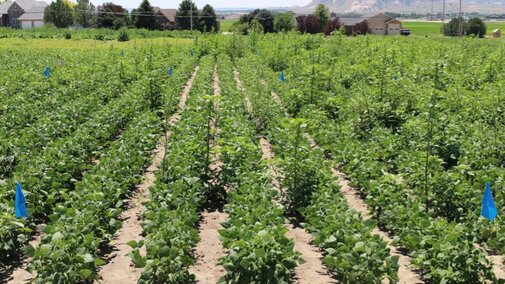Palmer amaranth has been in the Panhandle for at least the past 10 years. However, only in the past few years has the population surged throughout the region. If you are an irrigated crop producer and you are not currently dealing with Palmer amaranth, you will be soon. Palmer amaranth is a pigweed similar to redroot pigweed. Palmer grows faster, produces more seeds, and has a larger germination window. More importantly, it is resistant to group 9 (Roundup™) and group 2 (Raptor®/Beyond® and Pursuit®) herbicides that control other pigweed species.
When we consider the irrigated crops grown in the Panhandle of Nebraska, some crops are highly impacted by herbicide-resistant Palmer ― sugarbeet and dry edible bean ― as there are few, or in some cases no, alternative herbicides available. Sugarbeet and dry bean are also extremely susceptible to yield loss from Palmer amaranth. In studies conducted at the Panhandle Research Extension and Education Center, season-long Palmer amaranth interference at densities of one plant every five yards of row caused a 30% reduction in dry bean and sugarbeet yield. At one plant every yard, yield reduction in dry edible bean and sugarbeet was as high as 60% and 90%, respectively. This compares to 60-90% yield losses in corn and soybean only observed from densities as high as eight to 10 plants per yard.
Small grains, corn and alfalfa are not as impacted by Palmer amaranth competition and also have more herbicide options available to control herbicide-resistant Palmer. However, Palmer management is almost certainly going to get worse for those crops. Outside of western Nebraska, Palmer is resistant to group 27, 14, 5, 3, 15, 10, 2 and 9 herbicide modes-of-action, and these herbicide-resistant biotypes will continue to spread throughout the United States.
Palmer amaranth management is currently the most critical issue facing irrigated crop production within the Panhandle and the major focus of the Panhandle Weed Science Program. In past years, research projects focused on Palmer amaranth management focused on dry bean, sugarbeet, alfalfa, potato, sunflower, soybean and corn. In 2023, research will be conducted looking at four potential new herbicides in sugarbeet and two potential new herbicides for dry edible bean; comparisons of best herbicide programs in corn and potato; the use of directed-spray applicators and wick wipers to control Palmer amaranth escapes; and the use of cover crops, timing of crop planting, and other cultural strategies to manage Palmer amaranth.
For 2023, 16 separate field trials are planned for Palmer amaranth management. Most of these trials will be taking place at the Panhandle REEC, but several will also be taking place on cooperator's fields. These trials are also mostly funded by grower-directed groups such as Western Sugar Cooperative, the Nebraska Dry Bean Commission, and the Nebraska Potato Board, along with funding from the Nebraska Department of Agriculture and industry partners.
While much of this research may not have an impact this year, these projects are focused on benefiting Panhandle agriculture in the short-term; local, publicly available research focused on immediate needs. If you have questions about managing Palmer amaranth or would like to know more about this year’s ongoing research, or if you would like more information on upcoming field research tours, reach out to Dr. Nevin Lawrence at the PHREEC.
The High Plains Weed Tour is planned for Thursday, June 22, and the Panhandle Agriculture Research and Technology Tour will be held in August. The High Plains Weed Tour will focus predominantly on irrigated small grains, potatoes, soybean, corn and sugarbeet weed control trials, while PARTT will focus more on dry edible bean research.

